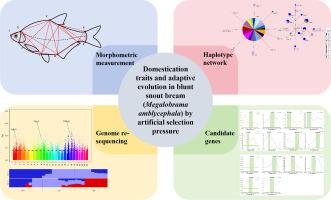Domestication traits and adaptive evolution in blunt snout bream (Megalobrama amblycephala) by artificial selection pressure
IF 2.2
2区 生物学
Q4 BIOCHEMISTRY & MOLECULAR BIOLOGY
Comparative Biochemistry and Physiology D-Genomics & Proteomics
Pub Date : 2025-08-05
DOI:10.1016/j.cbd.2025.101594
引用次数: 0
Abstract
Megalobrama amblycephala, a herbivorous freshwater fish species native to China, has become an important aquaculture species in Chinese freshwater polyculture systems due to its high economic value. How morphological traits and gene expression of cultured populations are influenced by different artificial selection pressures compared to wild populations is still poorly understood. In the current study, a combination of morphological analysis, cytochrome b sequence characterization, and whole genome re-sequencing methods was employed to investigate the genetic differences caused by artificial selection, including the genetic diversity and differentiation of wild and cultured populations. The genetic diversity of the population was classified based on the cytochrome b gene as follows: wild population (WP) > common breeding population (CP) > artificially created strain (AS). Morphological traits showed that the values of head length, body depth, dorsal fin length and pelvic fin length were the largest in the WP, smaller in the CP and the smallest in the AS. But the largest body width was in the AS, smaller in the CP, and the smallest in the WP. A significant finding was the identification of several candidate genes involved in carbohydrate metabolism, including Adcy9, Eif4ebp1, Gnai2b, Ppp1r3b, Ptprfa, Ptprfb and Slc8a2b. The data generated by this research not only contribute to a deeper understanding of the molecular-level characteristics but also provide crucial scientific foundations for the conservation and genetic improvement of this species.

人工选择压力下钝口鲷的驯化特性及适应进化
二头巨鲷(Megalobrama amblycephala)是中国土生土长的草食性淡水鱼,因其具有较高的经济价值,已成为我国淡水混养系统中重要的养殖品种。与野生种群相比,人工选择压力对养殖种群形态特征和基因表达的影响尚不清楚。本研究采用形态分析、细胞色素b序列鉴定和全基因组重测序相结合的方法,研究了人工选择导致的遗传差异,包括野生群体和养殖群体的遗传多样性和分化。根据细胞色素b基因对种群的遗传多样性进行分类:野生种群(WP) >;普通繁殖种群(CP);人工创造菌株(AS)。形态学特征表明,头长、体深、背鳍长和盆鳍长在水蚤中最大,在水蚤中最小,在水蚤中最小。体宽以AS最大,CP最小,WP最小。一个重要的发现是鉴定了几个参与碳水化合物代谢的候选基因,包括Adcy9、Eif4ebp1、Gnai2b、Ppp1r3b、Ptprfa、Ptprfb和Slc8a2b。本研究获得的数据不仅有助于深入了解该物种的分子水平特征,而且为该物种的保护和遗传改良提供了重要的科学依据。
本文章由计算机程序翻译,如有差异,请以英文原文为准。
求助全文
约1分钟内获得全文
求助全文
来源期刊
CiteScore
5.10
自引率
3.30%
发文量
69
审稿时长
33 days
期刊介绍:
Comparative Biochemistry & Physiology (CBP) publishes papers in comparative, environmental and evolutionary physiology.
Part D: Genomics and Proteomics (CBPD), focuses on “omics” approaches to physiology, including comparative and functional genomics, metagenomics, transcriptomics, proteomics, metabolomics, and lipidomics. Most studies employ “omics” and/or system biology to test specific hypotheses about molecular and biochemical mechanisms underlying physiological responses to the environment. We encourage papers that address fundamental questions in comparative physiology and biochemistry rather than studies with a focus that is purely technical, methodological or descriptive in nature.

 求助内容:
求助内容: 应助结果提醒方式:
应助结果提醒方式:


